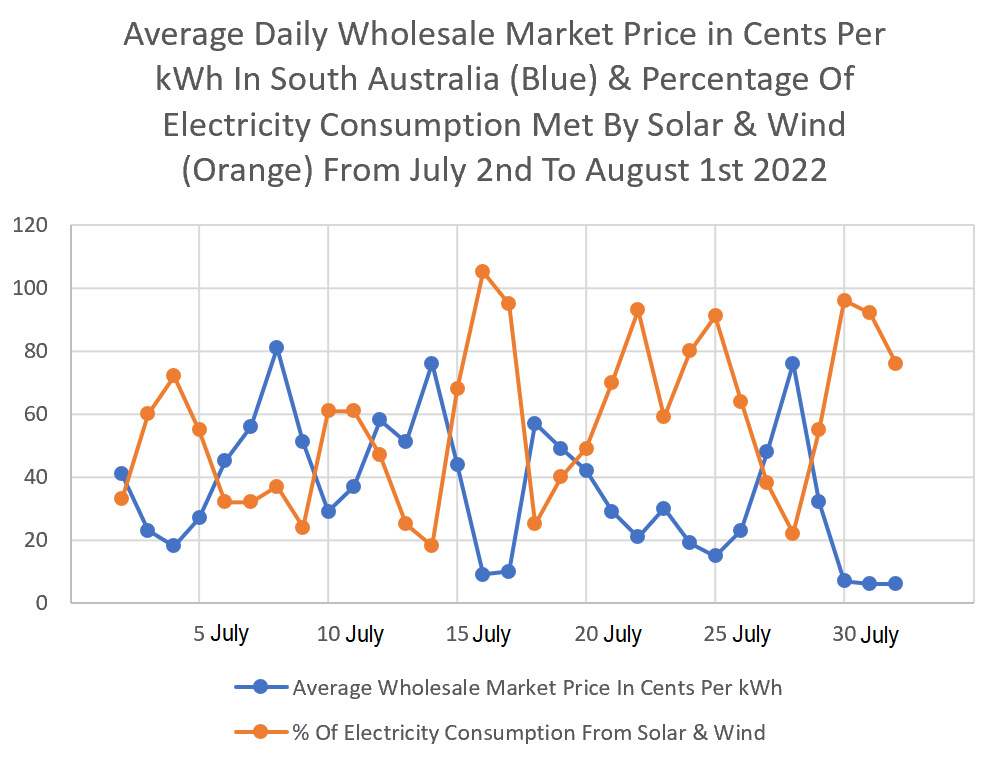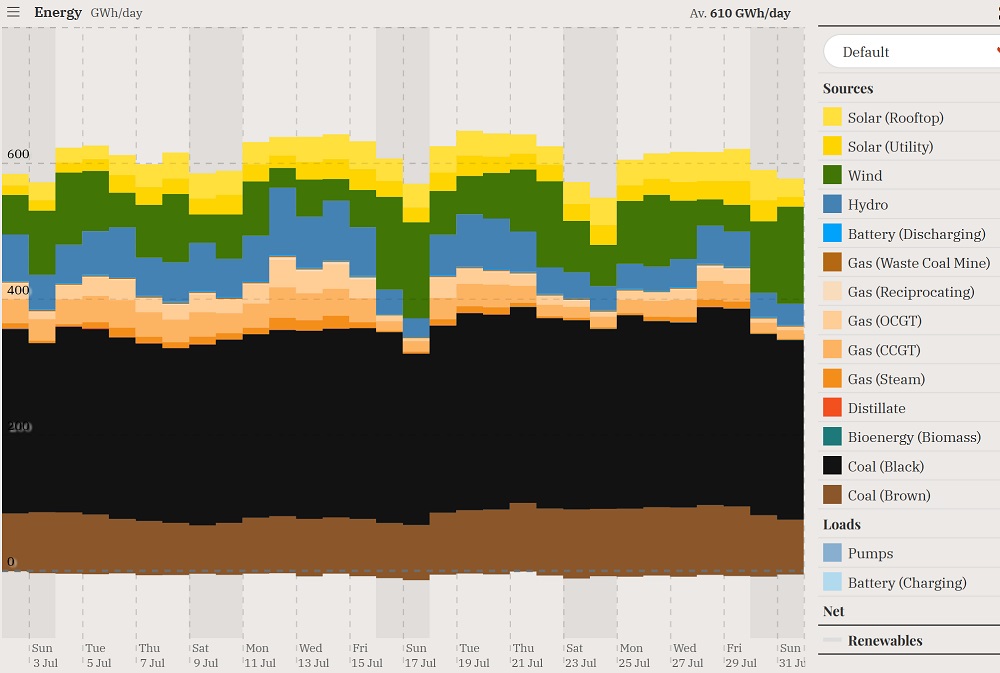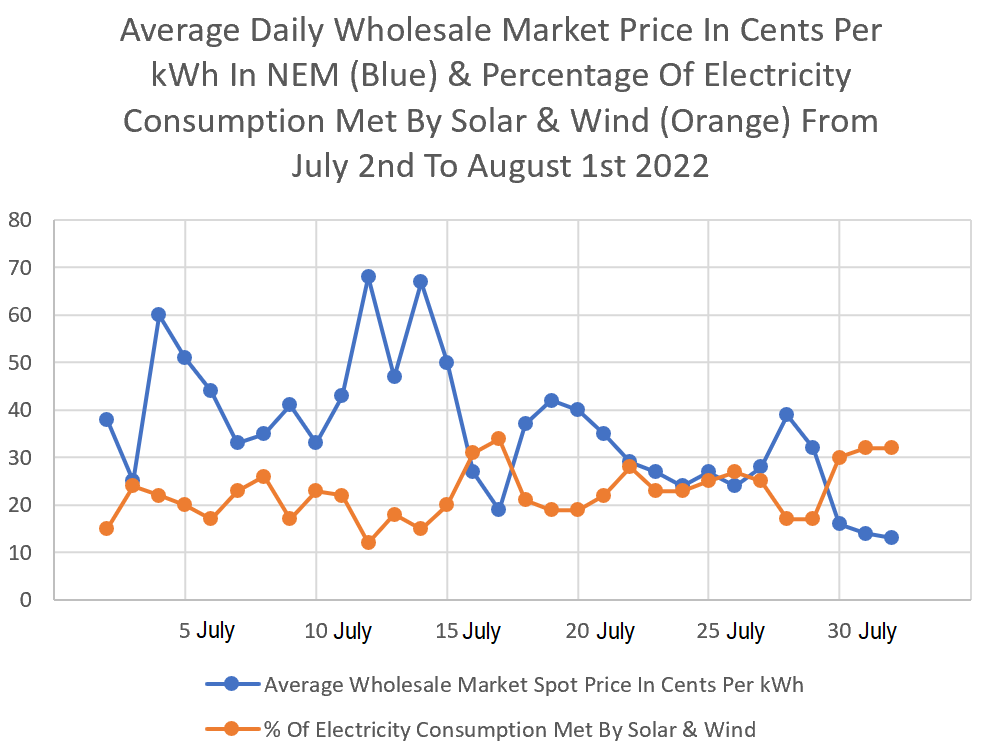
For four months now, electricity prices in the eastern states have been crazy high. But they’ve cooled down in the last three days to the point where they’re now just high.
This does not mean the National Electricity Market’s wholesale electricity price crisis is over. Nevertheless, this bodes well. It’s not just important, it’s bloody critical if we want to prevent further spikes in electricity prices that could be even more severe than the ones many Australians have just experienced.
We will have to wait and see if these more reasonable wholesale spot prices are just a blip. But fingers crossed this is the start of a trend and not just an aberration.

An aberration isn’t necessarily a bad thing. Just look at the friendly grin on this one’s face. (Image: D&D Monster Manual 5th ed.)
In July, the average wholesale market price in the eastern states averaged 37 cents per kilowatt-hour1. More than three times higher than the average for July last year. But over the last three days, the average wholesale electricity market price has been:
- Saturday the 30th of July: 16 cents per kWh
- Sunday the 31st of July: 14 cents per kWh
- Monday the 1st of August: 13 cents per kWh
Fingers crossed this downward trend continues. Things look good today so far, so we’re in the running for a 4th day of reasonable prices.
There are three main reasons why average wholesale electricity market prices over the past three days were merely high and not insanely high:
- While it wasn’t unusually warm by 21st-century standards, temperatures were generally pleasant for this time of year.
- Gas prices were lower.
- Renewable energy generation was high.
I will mention lower gas prices below, but in this article, I’ll mainly focus on how renewable energy has helped prevent wholesale electricity prices from becoming even worse. Also, I’ll mention what our newly minted Prime Minister said about renewables and electricity prices on Monday.
As for the weather, I’ll leave that up to god2. But climate? That’s all on us.
Australian Politics
I generally don’t pay much attention to politics. I instead try to focus on what’s important to me. These are, In order:
- My children.
- The condition of my lawn.
- Whether or not my children can be made to eat grass if the Council take my sheep away.
I don’t need to pay much attention to politics because when elections roll around, I just vote for whoever is least likely to get us killed. It’s generally not a difficult decision. My dream is one day I’ll have to think hard about who to vote for because none of the major parties will be morons when it comes to assessing risk.
The current mob in Canberra are a big improvement over the last lot when emission targets are compared, but I don’t see a lot of change in other areas. Where’s the requirement to wear masks in public indoor locations3? Currently, Australians are dying of COVID at more than twice the average rate Australian soldiers died during WW1.
But one thing our Prime Minister has gotten right, and repeated on Monday, is that renewables lower the cost of electricity. This is true and mostly because renewables have zero fuel cost. This doesn’t mean renewable energy is free. It costs money to make and install solar panels and build wind turbines. But once construction and commissioning of new wind and solar power capacity is completed, only low-cost maintenance is required to keep it operating.
Gas Prices Are Down
Renewable generation was above average over the past few days, while wholesale gas prices have been well below their recent averages. These two things are related. Higher renewable generation decreases gas demand, which lowers its price. But this only has a limited effect in eastern Australia because any gas that isn’t consumed can be exported for a currently sky-high price.
For the past few months, wholesale gas prices have been around $40 per gigajoule. But at 7:00 pm on Monday, August 1st, they were:
- Adelaide: $27.12
- Brisbane: $25.58
- Sydney: $22.82
- Victoria: $16.954
At $40 per gigajoule, a 33% efficient generator requires 43 cents worth of gas to generate one kilowatt-hour. At the Sydney price of $22.82 it drops to 25 cents. That’s a substantial improvement, but still a hell of a lot compared to the zero fuel cost of wind and solar power.
While natural gas only supplied 6.8% of Australia’s electricity over the past year, because it’s easily dispatchable (easy to turn on and off), it has a much greater effect on wholesale electricity prices than its portion of generation would suggest.
Renewable Generation Was Above Average
The Australian eastern states, which are all of them minus WA and NT, make up the National Electricity Market or NEM. The image below is from OpenNEM and shows the portion of generation from different sources:
Over the past 30 days the average generated from wind and solar power was close to 23%. On Saturday it was 30%, while on Sunday and Monday it was 32%. There was only one day in July when the percentage was higher, and that was 34% on the 17th.
To show the relationship between renewable generation and wholesale prices, I’ve made a graph displaying two things:
- The percentage of electricity consumption generated from solar and wind5 in the NEM states over the past month, and…
- The average daily wholesale electricity price in cents per kilowatt-hour.
Here it is:
While not as clear as it could be, there is a definite relationship between higher renewable generation and lower wholesale electricity market prices.
To make the relationship clearer, here’s the same graph for just South Australia. Over the past year, this state has generated electricity from wind and solar power equal to 65% of its consumption:

On the 17th of July, solar and wind power produced more electricity than the state consumed and the excess was exported to Victoria.
As you can see, there is a clear relationship between high wind and solar energy output and lower wholesale electricity market prices.
A Better Future With Renewables
While we can’t conclude much from just a few days of good news, with Europe now rationing gas and temperatures and solar power output slowly rising in Australia as we head into the final month of winter, there is reason for cautious optimism that wholesale electricity market prices will continue to trend downwards.
Unfortunately, in the short term, it will only take one cold snap to send them sky high again, but we can expect the overall direction to be downwards. How rapidly things will improve over the next few months is something no one knows for sure.
In the longer term, as Australia expands its solar and wind power capacity, we will see lower wholesale electricity prices. As battery storage expands, we’ll also see lower prices during the evening peak.
I just hope we’ll get lower wholesale electricity prices soon, otherwise we will see significantly higher electricity prices next year.
Footnotes
- The figures I’ve used for average NEM wholesale market prices are weighted averages. They’re approximate, so won’t be spot on, but do allow comparisons between periods. ↩
- God and her goddamned butterflies. ↩
- I approve of a requirement to wear masks for public health reasons because we sometimes need a push to do what’s sensible, but I don’t approve of massive fines to enforce it. They should be reminders to wear a mask, not budget-busting stress bombs. ↩
- Victoria has one price for the entire state because it is so tiny – it’s not even as large as New Zealand. ↩
- I haven’t included hydropower in this graph. It is renewable, but because it can be started and stopped at will and water in dams acts like fuel in a tank, its effect on electricity markets is very different. ↩



 RSS - Posts
RSS - Posts



Apparently the only premier called Colin Carpenter in WA had enough sense to call the bluff when a multinational said it will all the gas will be exported and they walked, but then came back and gave us 15% for domestic use. Sad to read that in the ES none of the politicians had enough negotiating skills to keep some of the gas locally.
By the way, now that they in the EU could be freezing in the dark, the EU decided gas and nuclear has become green enough!
Dominic Wild,
“Sad to read that in the ES none of the politicians had enough negotiating skills to keep some of the gas locally.”
I think that’s what is called “regulatory capture”:
https://en.wikipedia.org/wiki/Regulatory_capture
See also: https://michaelwest.com.au/the-great-gas-con-how-we-got-sucked-dry/
And it seems to me many voters (for more than a few terms of governments) have been ignorant of this or think this is acceptable. I’d suggest many Australians are now paying higher energy prices for their voting history.
“By the way, now that they in the EU could be freezing in the dark, the EU decided gas and nuclear has become green enough!”
I’d suggest the Laws of Physics and the constraints of chemistry and biology don’t ‘care’ about whether the EU may define gas & nuclear as “green enough”.
Fossil gas use is a reliable path to transition the Earth System to +4 °C global mean warming by 2100, and thus civilisation collapse.
Nuclear technologies are a reliable path for very slow deployments of new and horrendously expensive plants.
https://www.solarquotes.com.au/blog/solar-supply-chain-mb2546/#comment-1480179
Meanwhile, published on Aug 1 by PNAS was a perspective paper titled Climate Endgame: Exploring catastrophic climate change scenarios, concluding with (bold text my emphasis):
https://www.pnas.org/doi/full/10.1073/pnas.2108146119
Building nuclear power stations is always an enormously costly experience, and even then, history shows accidents can and do happen. Such accidents require more expenditure (taxpayers to the rescue?) to make them “safe” again. And there’s always the problem of nuclear waste disposal, which, in the UK, is handled by “flask trains” which run overnight. Keeps the odd railway line open…
But the final blow to the cost effectiveness of nuclear power is that of dismantling. After the useful life of the power station has expired the cost of clean-up can, and does, run into billions of pounds/dollars and can take up to twenty years – have a look at the clean-up of the Sellafield and Dungeness in the UK – https://www.theguardian.com/environment/2022/may/20/uk-nuclear-power-stations-decommissioning-cost.
Sadly, opposition leader Peter Dutton just doesn’t get it.
Ironically I was just reading a piece yesterday on JPost about nuclear energy, starting with President Eisenhower’s 1953 vision. According to the article, “nuclear power is significantly more reliable, effective and safe than other alternative forms of energy”.
Feel free to dispute the claim – the article didn’t define alternative forms of energy, just that Russian gas isn’t an option, and a reference to coal. If wind and solar aren’t an option, gas is too dangerous given Russia, and coal is deemed bad, what other than nuclear is left?
George, a few truisms.
Progress for most societies is never at a standstill. For example, the efficiency of solar arrays has improved (and is still improving) compared with the first models. Work on nuclear fusion is continuing, as is research into large storage batteries. So change is always with us; back in the early 20th century who could have foreseen the demise of the steam locomotive, the film camera, shellac recordings, and b&w 4:3 frame television?
One thing is certain. The planet is finite but our population growth is not. We are where we are because of the world’s various economic “-isms”, all of which demand constant growth which in itself is unsustainable. Human greed has effectively contributed to the present global warming, assisted by once-cheap fossil fuels. They are no longer the answer, and neither is nuclear.
But don’t give up hope!
I have lots of hopes, but they may differ to those of the majority here. :-|)
Yes the planet is finite, but so is the universe. That we cannot access something doesn’t mean the resources don’t exist. We could for instance build massive subterranean cities, but we won’t, or use drones to harvest asteroids, but we don’t. There’s simply no financial justification or sufficient human interest to do such.
Constant growth unsustainable? Actually the only thing clearly unsustainable is to cease growing – stasis is death. Without a growing young base there is no support for the older population – retirement pension, healthcare etc. Yes we could adopt the traditional model of family caring for elders, but that doesn’t work for today’s Western world and how many children/daughter-in-laws’ have the training, ability, and interest to care for their elders?
Greed may indeed be an issue – consumerism etc, but how do we change society from ‘needing’ that ‘newest shiniest and greatest’ iPhone ever? (Official disclaimer – I’ve never used one and don’t plan to). Being satisfied with what you have, buying quality, and only changing it when it dies (whatever it may be). Am I just old fashioned?!? A ‘cradle to grave’ or multigenerational lifecycle for products is pretty much incomprehensible these days.
Fossil fuel and nuclear energy (Australia has the largest reserves), continue to be seen as economically viable around the globe. By contrast unreliable energy remains incapable of meeting all future demand, let alone replacing all current needs. Perhaps one day this won’t be true but for now we simply don’t have the capability.
“Fossil fuel and nuclear energy (Australia has the largest reserves), continue to be seen as economically viable around the globe.”
This is not correct. Please try to be more accurate. Australia’s existing coal power stations are closing down because they are not financially viable. If you can build a nuclear power plant cheaper than a coal power station, well… Normally, I’d have no problem at all living next to a modern nuclear power plant, but I think I’d make an exception for that one.
Ronald, if coal is considered economically non-viable, why are coal plants continuing to be built around the globe? Coal plants in Australia are heading for extinction because most are old, and more importantly, the Green\climate change crowd hate them. If Australian coal is indeed prohibitively expensive, why are India, Japan, South Korea, Taiwan, Vietnam, a variety of others, and even China still keen to buy it? Now if the issue isn’t coal but Australian power plants, that’s a slightly different issue.
ROFL. Very few in the First World would want to live next to a cheap built plant. Nuclear would be worse than most, but honestly a cheap hydroelectric dam or even a cheaply built coal plant would be an undesirable neighbour.
George Kaplan,
“…if coal is considered economically non-viable, why are coal plants continuing to be built around the globe?”
I’d suggest these investors don’t know any better and are likely to be caught with “stranded assets” in future.
Outside China, most countries have been scaling back their coal plans, leading global coal power capacity outside China to decline since 2018. See Figure 1: Global commissioning and retirements and the net change, 2000–2021 (gigawatts) in Global Energy Monitor’s latest report titled Boom and Bust 2022: Tracking the Global Coal Plant Pipeline.
“Coal plants in Australia are heading for extinction because most are old…”
…and going broke. Engineering and economic reality; not ideology – I think we’ve been through this before, George. ?
https://reneweconomy.com.au/theyre-going-broke-esb-chair-says-coal-plant-closures-now-unavoidable/
“If Australian coal is indeed prohibitively expensive…”
It seems so. The Newcastle thermal coal benchmark price has risen from around US$65 per tonne at the beginning of 2020, peaking at about US$432/T on 13 Jul 2022 (6.6 times the early 2020 price), then falling to circa US$360/T now (5.5 times).
https://tradingeconomics.com/commodity/coal
…and even China still keen to buy it?
Apparently not, George!
https://www.cnbc.com/2022/07/01/china-clears-backlog-of-australian-coal-but-beijing-may-not-buy-soon.html
Very few in the First World would want to live next to a cheap built plant. Nuclear would be worse than most…”
You think so, George? ??♂️
George Kaplan (re your comments on August 5, 2022 at 2:40 pm),
“Fossil fuel and nuclear energy (Australia has the largest reserves), continue to be seen as economically viable around the globe.”
Seen by whom as “economically viable”? You, George? ??♂️
Meanwhile, energy and commodities columnist at Bloomberg tweeted earlier today (Aug 9):
https://twitter.com/JavierBlas/status/1556652176906371072
Where’s this so-called “economically viable” nuclear power, George? ?
“By contrast unreliable energy remains incapable of meeting all future demand, let alone replacing all current needs.”
George, are you referring to apparently unreliable energy from some French ‘baseload’ nuclear plants? ?
https://www.powermag.com/nuclear-power-production-curtailed-in-france-worsening-europes-energy-crisis/
Ronald Brakels,
“I approve of a requirement to wear masks for public health reasons because we sometimes need a push to do what’s sensible, but I don’t approve of massive fines to enforce it.”
What are the risks and potential consequences becoming infected with SARS-CoV-2 (COVID-19)?
Professor MacIntyre highlights in Slides 41 through to 50 that evidence/data indicates that the 2 metre social separation rule is useless for airborne viruses like SARS-CoV-2. Factors that determine the probability of an uninfected person acquiring an infectious dose from an infected person depends on:
• whether the infected person is mask wearing, what type of mask is worn and how it is worn;
• whether the uninfected person is mask wearing, what type of mask is worn and how it is worn;
• the duration of exposure; and
• the degree of air movement/filtration/replenishment at the venue.
https://exchange.isid.org/isid/2022/isid-webinars-2022/356886/faculty.presenters.covid-19.pandemic.or.endemic.html?f=menu%3D16%2Ac_id%3D356886%2Afeatured%3D17649
Deaths from SARS-CoV-2 in Australia so far:
Period _ _ _ _ _ _ _ _Days_ Accumulated Total _ Total for Period _ Average deaths/day
2020, Mar 01 to Dec 31: 306 _ _ _ 909 _ _ _ _ _ 909 _ _ _ _ _ _ 2.97
2021, Jan 01 to Dec 31: 365 _ _ 2,239_ _ _ _ _1,330 _ _ _ _ _ _ 3.64
2022, Jan 01 to Aug 03: 215 _ _12,009 _ _ _ _ 9,770 _ _ _ _ _ _45.44
https://covidlive.com.au/report/daily-deaths/aus
Deaths attributed to SARS-CoV-2 for the full year in Australia, on current trends could total around 16,500 (or more). So, it seems SARS-CoV-2 is proving to be a major cause of death, potentially second only to ischaemic heart diseases (53.8 average deaths/day in 2019 & 49 average deaths/day in 2020), or perhaps worse.
https://www.abs.gov.au/statistics/health/causes-death/causes-death-australia/2020
The death statistics are only part of the story – ‘long-COVID’ is another growing factor that threatens the longer-term health of many of our population.
https://www.sydney.edu.au/news-opinion/news/2022/06/30/long-covid-presents-a-major-health-challenge-how-can-australia-b.html
See also: https://ozsage.org/media_releases/australia-must-plan-now-for-a-significant-burden-of-disease-and-disability-due-to-long-covid/
I’d suggest wearing a mask may save your (or others’) health/life, and reduce stresses on the health system and economy.
You can’t have a healthy economy without fit & healthy workers.
It’s not a good situation, with tragic results. While I did not think our response would be perfect, I never thought it would get this bad. Over the past week we’ve averaged 94 COVID deaths a day.
Masks will not work over the beard, are you willing to shave to increase your protection Ronald?
I have had a beard almost 6 months and things will have to get a lot worse before it is an option for me.
Clean shaven is best, but wearing a mask over a beard still helps. I use an N95 one with two elastic bands that go around the back of the head. If you can feel the air you breath passing through the mask than at least that is being filtered. And if air goes through your beard instead, that’s better than nothing. Slowing the air down gives time for the larger droplets of spittle to either drop or get caught in your beard instead of entering your body. But I’m not in a high risk occupation. I’m currently working with zero other people in the room.
Nuclear is safe. Fewer people have died from nuclear accidents than coal fired or wind farm accidents. Today’s nuclear power plants are not comparable to those built in the sixties or in Soviet states, which is what most of the hyperbole around the safety of nuclear power is focused on.
Modern methods for waste recycling and disposal are safe, as is the decommissioning of power plants. Don’t believe everything you read in the Guardian.
https://world-nuclear.org/information-library/nuclear-fuel-cycle/nuclear-wastes/radioactive-waste-management.aspx
https://world-nuclear.org/information-library/nuclear-fuel-cycle/nuclear-wastes/decommissioning-nuclear-facilities.aspx
Meanwhile, the only alternatives for consistent and reliable power are fossil fuel based (coal, gas) which exacerbates climate change. Renewables are great when they can complement other more reliable power sources but we don’t have a reliable and cost-efficient way of storing the energy that they produce yet, which leads us back to gas.
Brendan, I’m afraid you are living in the past. A considerable way back. Firmed solar and wind are a far cheaper option for Australia than fossil fuels and/or nuclear. Here’s a summary of the latest AEMO gencost report and there’s a link to the full report at the bottom:
https://www.csiro.au/en/news/news-releases/2022/gencost-2022
Brendan,
“Today’s nuclear power plants are not comparable to those built in the sixties or in Soviet states…”
Yep, the newer plants are much more expensive and slower to deploy (i.e. plan/approve, license, procure materials/parts, site prepare, construct, grid connect & commission), compared with plants built before the Chernobyl & Fukushima events.
“Modern methods for waste recycling and disposal are safe…”
How long for, Brendan? The toxic waste legacy will long outlast any energy benefits gained.
“Don’t believe everything you read in the Guardian.”
The World Nuclear Industry Status Report 2021 is the latest annual report, at 409 pages, that provides an in-depth analysis of nuclear power, using plant-level data to assess its global status, and contains several focus chapters. Have a ? at the comprehensive data in that, or is this information too inconvenient for your narrative, Brendan? ?
https://www.worldnuclearreport.org/World-Nuclear-Industry-Status-Report-2021-773.html
“Renewables are great when they can complement other more reliable power sources but we don’t have a reliable and cost-efficient way of storing the energy that they produce yet…
There are already reliable and cost-effective ways of storing the energy. I’d suggest you are just not looking effectively, Brendan.
See the presentation by Andrew Blakers referred in my comments at: https://www.solarquotes.com.au/blog/albanese-climate-australia-mb2484/#comment-1460575
No mention is ever made about the fact that the NEM sets the 5 minute price for all generators in the NEM in such a way the every generator get the same price. It all depends on the generator whose bid is accepted for the 5 minutes. If a gas generator sets a price of $300 / MWh the all other generators, solar, wind, hydro, etc., gets paid $300 / MWh.
Today I stumble upon AEMO’s average price page. (I cannot get a URL to take you straight there.)
For Victoria, for the year ending June last year, average price was 4.6c/kWh, for this year it was 10c/kWh, and next year is predicted at 29c/kWh. Yikes!
Feed-in tariff is set a bit above the average wholesale price.
So if this prediction holds true, I estimate that the payback period for solar will be less than two years.
Of course AEMO’s prediction for the year ending last month was 4c/kWh, so their prediction record is not good.
Even if next year’s feedin tariff follows the year just past, we are looking at 11 or 12c.
Any comment Ronald?
Generally speaking, the feed-in tariffs for this financial year were decided on in May and so missed the massive run-up in wholesale electricity prices through June, July, and August. Even if we assume the average wholesale price for the rest of the financial year is 4.6 cents, the three months of ridiculous prices should result in a significant increase in solar feed-in tariffs next year. How much of an increase will depend on how much electricity was sold through contracts that were set at reasonable prices. Presumably, most electricity was sold this way, as large purchasers of electricity would have wanted to protect themselves from price increases that were on the cards after Russia invaded Ukraine.
The Victorian mandated minimum tariff for 22/23 was set in January.
https://www.esc.vic.gov.au/electricity-and-gas/prices-tariffs-and-benchmarks/minimum-feed-tariff/minimum-feed-tariff-review-2022-23#toc-how-we-calculate-the-minimum-feed-in-tariff has:
“We calculate the minimum feed-in tariff starting by forecasting the wholesale price of electricity for the year ahead. … ”
The act actually has:
“In determining a rate for the purposes of section 40FBA(a), the Commission must have regard to—
(a) prices of electricity in the wholesale electricity market….”
Which would appear to fix ESC forecast prices to the AEMO market price, independent of contracts.
Other states and individual companies will be of course be different.